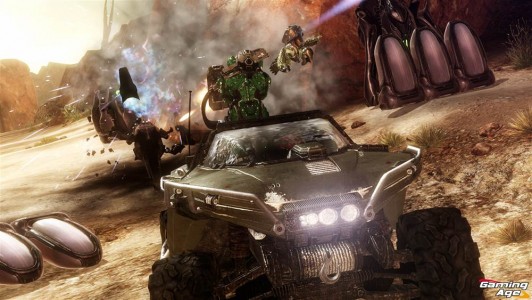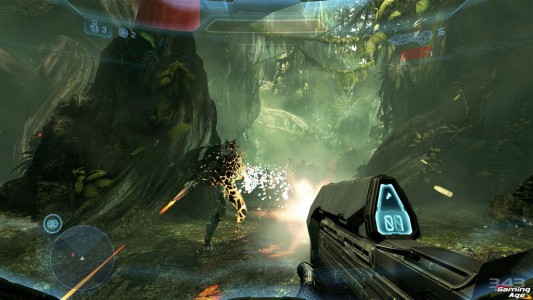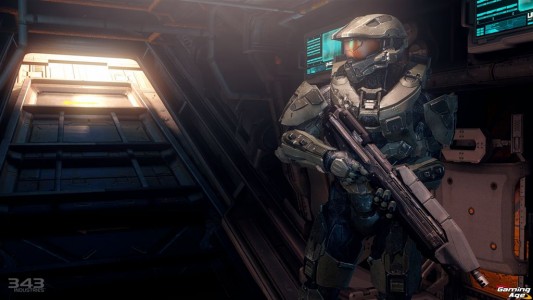Publisher: Microsoft Game Studios
Developer: 343 Industries
Medium: DVD-ROM
Players: Multi
Online: Yes
ESRB: T
It?s natural for fans to have some sort of trepidation going into the release of Halo 4, after all, it?s the first non-Bungie developed Halo outside of Anniversary. And 343 Industries might be comprised of a lot of folks that love the franchise, and have overseen a lot of its supplemental universe development, but as far as developer track records go their team as a whole is sort of unproven. So it?s certainly worth saying that having played through Halo 4?s campaign, new Spartan Ops missions, and having spent a decent time with the game?s multiplayer component, I think the Halo franchise is in completely capable hands here.
The plot for Halo 4 picks up a little while after the end of Halo 3, which ended with Master Chief and AI Cortana essentially asleep inside a vessel drifting through space. When Halo 4 begins, we find the Chief and Cortana much as we left them, but they are quickly awakened after being scanned by an unknown source, and come to find that while Earth may be at some form of tentative peace with the Covenant, that apparently not everyone got the same message. From there the story escalates in typical Halo fashion, as Master Chief and Cortana touch-down on a new planet, constructed by the mythical Forerunners, and populated by the new enemy type dubbed Prometheans.
 From a control perspective the game feels downright identical to the Bungie developed games in the series. There?s an appropriate amount of float to Master Chief?s jumps, and vehicles like the Warthog or Ghost that reappear here control just like you remember. 343i certainly hasn?t taken a lot of liberties with the groundwork built over the course of the previous three numbered entries, which is certainly a good thing, because after all if it?s not broke, don?t fix it. There are some additions, like the use of permanent timer based power-ups from Reach that Master Chief can now make use of, introducing elements like the jetpack and hard light shields for temporary deployment. Also, gone is the ability to duel wield weapons this time out, so you?ll just cycle between your two equipped, along with three grenade types composed of standard frag and plasma, with one new addition.
From a control perspective the game feels downright identical to the Bungie developed games in the series. There?s an appropriate amount of float to Master Chief?s jumps, and vehicles like the Warthog or Ghost that reappear here control just like you remember. 343i certainly hasn?t taken a lot of liberties with the groundwork built over the course of the previous three numbered entries, which is certainly a good thing, because after all if it?s not broke, don?t fix it. There are some additions, like the use of permanent timer based power-ups from Reach that Master Chief can now make use of, introducing elements like the jetpack and hard light shields for temporary deployment. Also, gone is the ability to duel wield weapons this time out, so you?ll just cycle between your two equipped, along with three grenade types composed of standard frag and plasma, with one new addition.
Map layouts for the Campaign and Spartan Ops missions feel suitably open ended, featuring a number of ways to take on and engage in most firefights. I can?t stress enough how familiar this will all feel to Halo fans, and again, while 343i might be new at the developer helm, they definitely know what they?re doing when it comes to the Halo franchise. There?s no feathers really being ruffled here, but there?s enough new elements via the Prometheans and their weapon set that still manage to give this game a fresh feeling. But the core components of combat, namely that almost puzzle like quality to figuring out how to take on a group of foes in an open, arena like setting, remains largely untouched and intact.
 Outside of the Campaign mode, Halo 4 offers up some much anticipated multiplayer via the newly dubbed Infinity mode. Infinity contains both your standard competitive multiplayer modes, and the new Spartan Ops mode, which replaces Firefight from the last couple of games. Spartan Ops is actually pretty fun, offering up what is essentially five mini-stages every week via downloadable content for free to Halo 4 owners. These stages can be played solo or cooperatively with friends, have actual story hooks to them, and offer up new characters and scenarios not already featured through the campaign mode of the game, and also take place after the end of the campaign. It?s a really great, feature rich addition to the game, which also serves as a smart move to keep players interested in continuing to play Halo 4 long after they?ve beat the hell out of the campaign, especially for the folks that love Halo but don?t care for the competitive multiplayer angle.
Outside of the Campaign mode, Halo 4 offers up some much anticipated multiplayer via the newly dubbed Infinity mode. Infinity contains both your standard competitive multiplayer modes, and the new Spartan Ops mode, which replaces Firefight from the last couple of games. Spartan Ops is actually pretty fun, offering up what is essentially five mini-stages every week via downloadable content for free to Halo 4 owners. These stages can be played solo or cooperatively with friends, have actual story hooks to them, and offer up new characters and scenarios not already featured through the campaign mode of the game, and also take place after the end of the campaign. It?s a really great, feature rich addition to the game, which also serves as a smart move to keep players interested in continuing to play Halo 4 long after they?ve beat the hell out of the campaign, especially for the folks that love Halo but don?t care for the competitive multiplayer angle.
Of course, competitive multiplayer is still present in full force, with a handful of changes. One, the True Skill system adopted from Halo 3 onwards, is completely gone, or at least missing on a surface level. Matchmaking is divided across all the various modes featured in multiplayer, containing returning favorites like Team Slayer, King of the Hill, Oddball and more, along with newer modes like Flood and Regicide. Once you enter the Infinity menu, you?ll select War Games to participate in multiplayer. From there you?ll get a list of the available modes, 9 in all, with a breakdown of players currently playing each mode. Gone is the mixed playlist approach, so if you pick Infinity Slayer, you?ll be playing nothing but Team Slayer.
 The game also incorporates a leveling and customization system similar to Halo: Reach. While matchmaking doesn?t use True Skill to match up players, teams are generally evenly divided by the player level of everyone that?s joined up for a round. I imagine this is going be kind of disappointing for some players, and it does seem like it?ll make it tougher to be properly matched with players of comparable skill. It feels more akin to the Call of Duty method of matchmaking, and does feel like an odd step for the series to take. Part of the reasoning, from what I understand, is that the True Skill system was a bit broken by players boosting and manipulating the system, but I never had much of an issue with it and find it to be the sole disappointing change made in Halo 4.
The game also incorporates a leveling and customization system similar to Halo: Reach. While matchmaking doesn?t use True Skill to match up players, teams are generally evenly divided by the player level of everyone that?s joined up for a round. I imagine this is going be kind of disappointing for some players, and it does seem like it?ll make it tougher to be properly matched with players of comparable skill. It feels more akin to the Call of Duty method of matchmaking, and does feel like an odd step for the series to take. Part of the reasoning, from what I understand, is that the True Skill system was a bit broken by players boosting and manipulating the system, but I never had much of an issue with it and find it to be the sole disappointing change made in Halo 4.
One cool addition to the leveling system is the use of specialization classes which are unlocked once you reach a certain experience level. From here you can choose class options that?ll unlock new skills and abilities for your Spartan, and these specialization classes can be changed. These classes unlock not only very specific and unique abilities that carry over from War Games into Spartan Ops and vice versa, but also offer up more unique armor sets to help your selected Spartan stand out from the crowd. There?s a whole lot of customization options present here, and the addition of these specializations give players a bigger incentive for leveling up than just standard weapon unlocks and a bigger number next to your online tag.
 Also worth noting about online multiplayer is that the ability to join a group of friends online, or send out invites for people to join, is remarkably easy. At any time, while in any menu screen for Halo 4, you can simply press the X button and jump right into your friends list via the Halo menu, without access the 360 dash. This in itself isn?t remarkable, but the access is instantaneous, allowing you to send out invites quickly with the press of a button, and breaks down your friends list conveniently by people playing Halo 4 and those that aren?t. It also temporarily adds players present in a round to this list, so if you enjoyed playing with someone new you can easily add them without much hassle, and you can quickly control party settings from the same interface.
Also worth noting about online multiplayer is that the ability to join a group of friends online, or send out invites for people to join, is remarkably easy. At any time, while in any menu screen for Halo 4, you can simply press the X button and jump right into your friends list via the Halo menu, without access the 360 dash. This in itself isn?t remarkable, but the access is instantaneous, allowing you to send out invites quickly with the press of a button, and breaks down your friends list conveniently by people playing Halo 4 and those that aren?t. It also temporarily adds players present in a round to this list, so if you enjoyed playing with someone new you can easily add them without much hassle, and you can quickly control party settings from the same interface.
From an audio/visual standpoint, Halo 4 has some noticeable improvements and changes as well. It?s hard to deny that Halo?s soundtrack up to this point has been pretty iconic, there are standout themes that will always be instantly associated with the franchise, thanks to the excellent work done by composer Martin O?Donnell. One of the things that I actually enjoyed about Halo 4?s soundtrack, though, is that it?s largely made up of new, original material for the series. Only one track that I can think of harkens back a bit to the classic Halo theme, but for the most part new composer Neil Davidge has done an excellent job of crafting a unique soundtrack for this release. There?s plenty of standout tracks here, like the haunting ambience of Solace, or the fantastic menu themed provided by the track To Galaxy. Seriously, the soundtrack is full of great material, and well worth a purchase in itself.
 It?s also hard to deny that Halo 4 is a hell of a visual step up for the series. Part of that comes from the art design, featuring bright, neon like colors that infuse the new world of Requiem with inorganic life. But the texture work and character models are a step above what Reach produced, and help to show that that 360 still has a trick or two up its sleeve from a power perspective, even this late in the console life cycle. It?s easily the best looking Halo game to date, and certainly serves as a suitable pre-cursor for what we can expect from the series going forward, and moving into next-gen.
It?s also hard to deny that Halo 4 is a hell of a visual step up for the series. Part of that comes from the art design, featuring bright, neon like colors that infuse the new world of Requiem with inorganic life. But the texture work and character models are a step above what Reach produced, and help to show that that 360 still has a trick or two up its sleeve from a power perspective, even this late in the console life cycle. It?s easily the best looking Halo game to date, and certainly serves as a suitable pre-cursor for what we can expect from the series going forward, and moving into next-gen.
Safe to say, I found very little of Halo 4 to be disappointing, and think that 343 Industries has done a fantastic job with taking over the reins from series creator Bungie. Halo 4 is a fantastic, open first person shooter worthy of the franchise, and something that both longtime fans, and newcomers, will definitely enjoy. Despite some mildly baffling changes to multiplayer matchmaking, this marks an excellent entry in the series, and something that fans won?t want to miss come November 6th.

